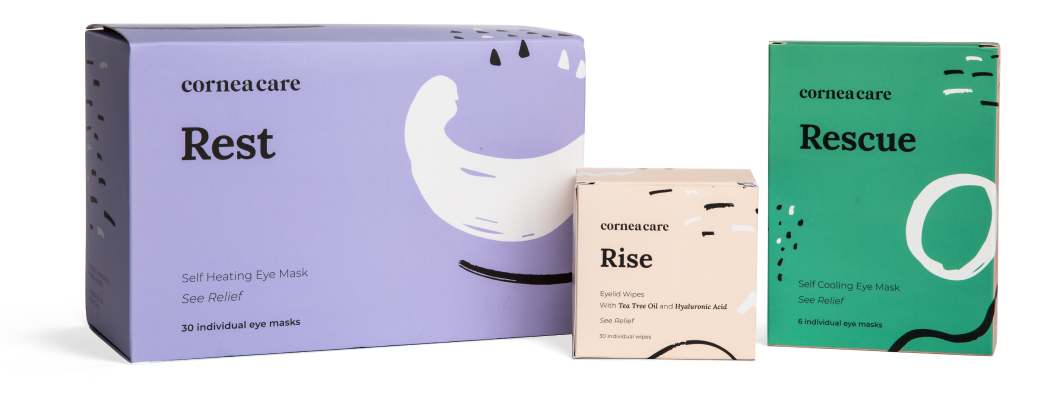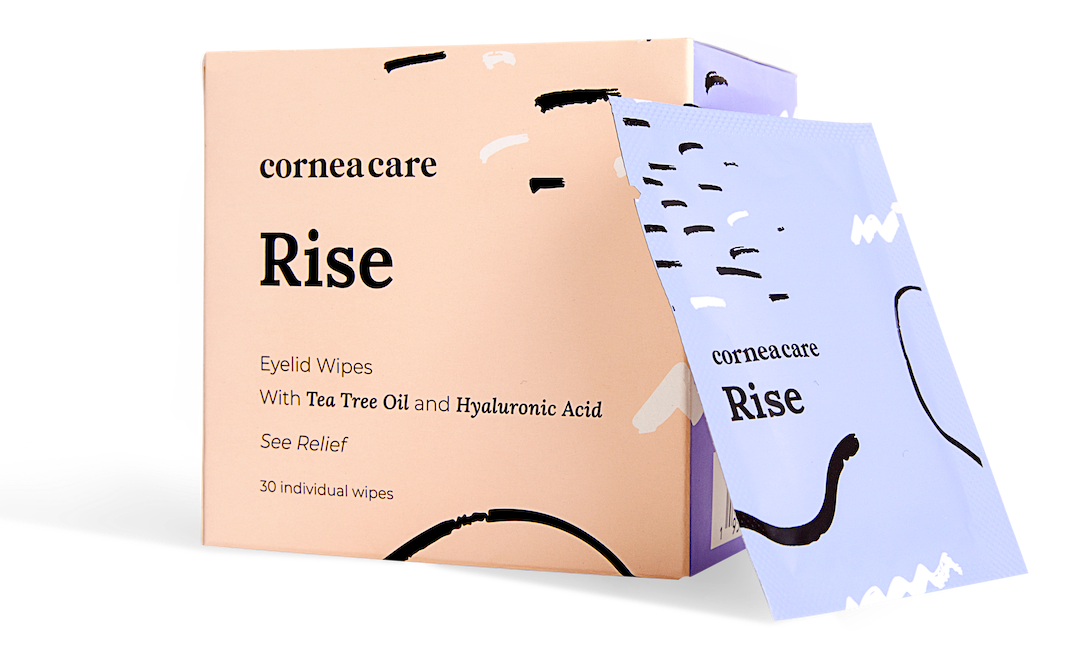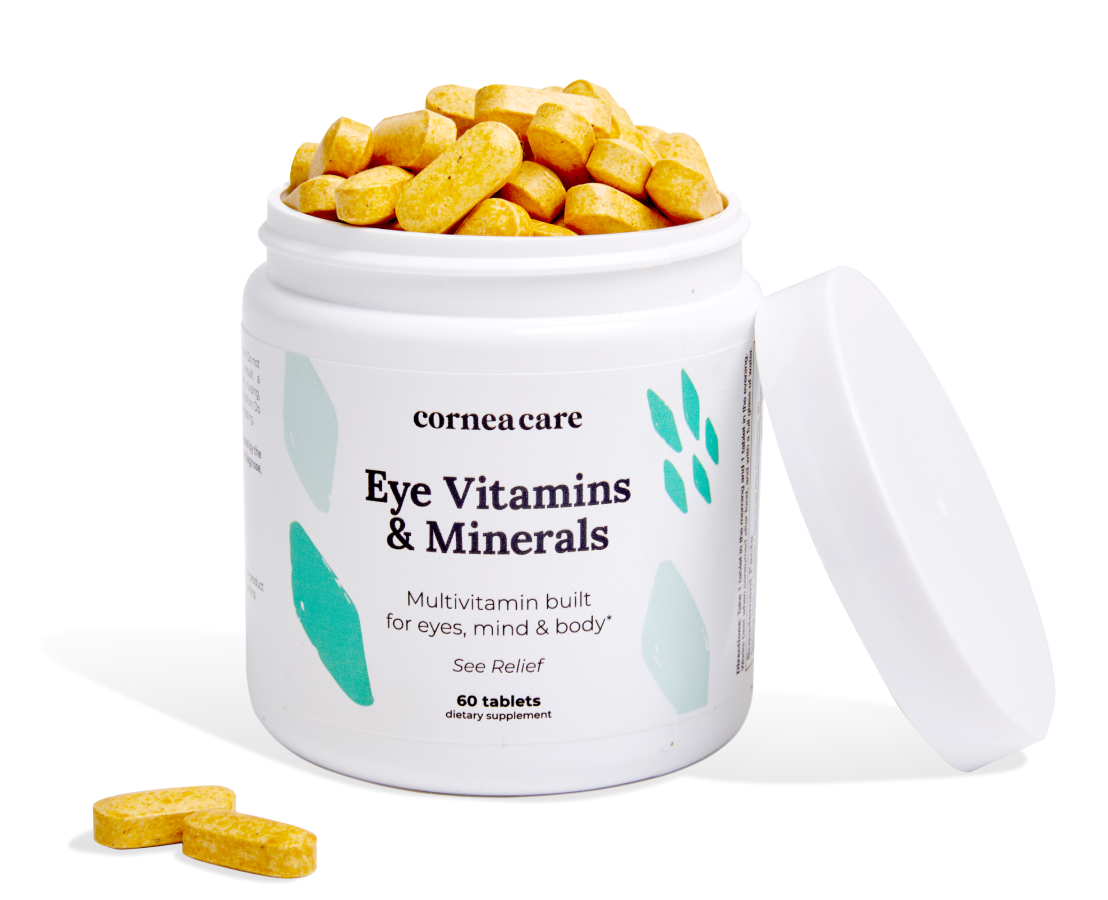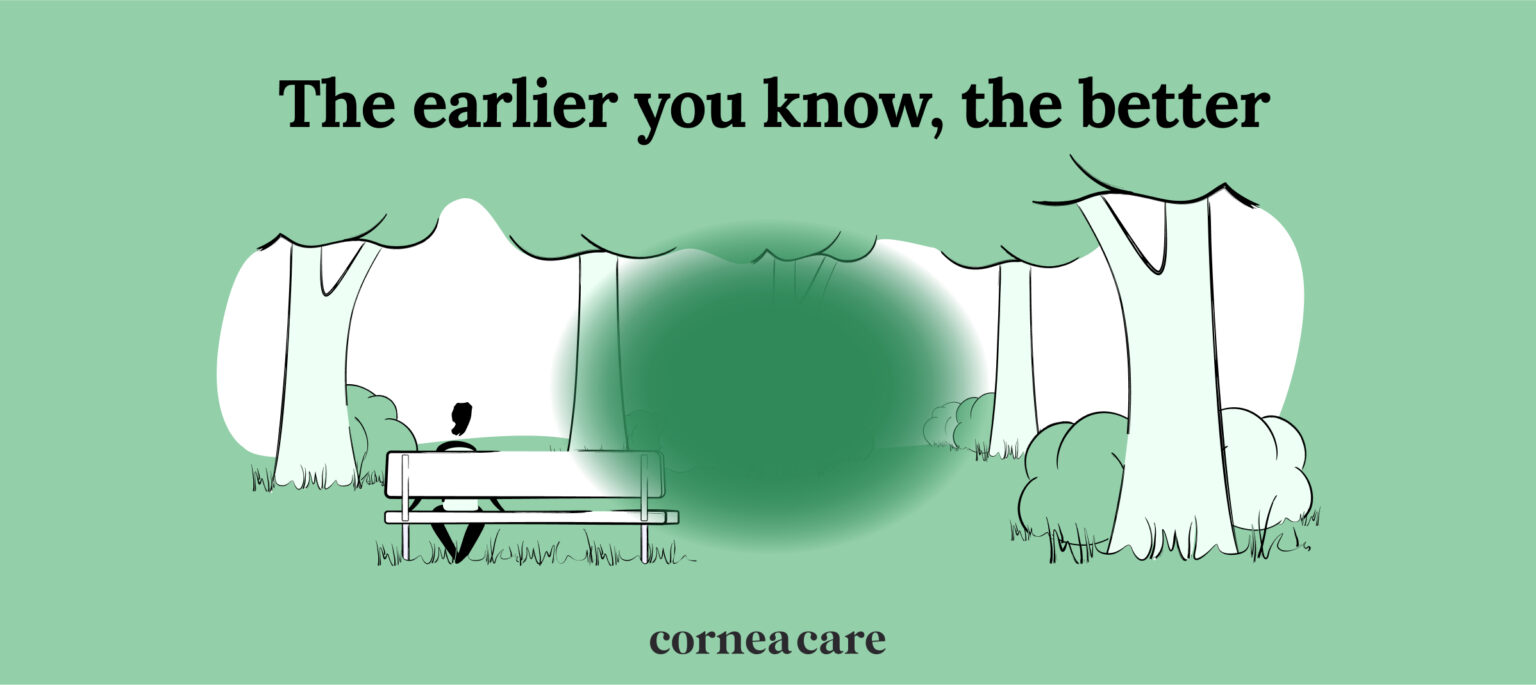Age-related macular degeneration (AMD) is the leading cause of central vision blindness in adults over the age of 60.1 New treatments and ongoing research have made this disease more manageable over the years. Even so, with age-related macular degeneration, early detection remains the key to managing the progression of this disease.
This condition primarily affects the central portion of your retina, called the macula, which is the region of the retina responsible for central vision. When your macula is affected by retinal disease, you can begin to find activities such as reading and driving become challenging, while your peripheral vision remains clear.1
Knowing the symptoms and risk factors for AMD, and seeing your eye doctor for regular eye exams, can ensure early detection and prompt treatment, should you develop age-related macular degeneration.1
Key Points
- There are two types of age-related macular degeneration: the most common is the dry form (called dry AMD) and the less common, more serious wet form (called wet AMD).
- Characterized in later stages by symptoms that include blind spots and visual distortion in the central vision, your eye doctor will look for yellow deposits, called drusen, or abnormal blood vessels to make a diagnosis of AMD.
- With age-related macular degeneration, early detection is key to beginning treatment to prevent or reverse vision loss.
What is Age-Related Macular Degeneration?
Age-related macular degeneration (AMD) is a disease of the retina that gradually worsens over the years. It is considered the primary cause of serious vision loss in aging adults.2
The retina is located at the back of your eye, and its job is to sense the light that enters your eyes and send signals to your brain that are translated into images. The small central portion of your retina is called the macula, and with age-related macular degeneration, it wears down as you age causing loss of vision.2
AMD progresses through stages designated as early, intermediate, and advanced. Your eye doctor (optometrist or ophthalmologist) can determine the stage of your disease based on a complete eye exam.
Early AMD is indicated by the finding of yellow deposits, called drusen, under the retina. Drusen occur in healthy, aging eyes as well, but as the numbers increase, AMD is often diagnosed. With early AMD, there is no pain or discomfort, and you may not notice any vision changes at all.1
Intermediate AMD is marked by a significant increase in the number and size of drusen. At this stage, AMD patients are at greater risk of vision loss and progression to advanced AMD and possibly wet AMD. In this stage, you may notice certain signs of AMD, including central vision problems and some loss of visual acuity, especially while reading.1,2
Advanced AMD is diagnosed when your doctor finds atrophic retinal cells or abnormal blood vessel growth, called choroidal neovascularization (CNV).1
Two Types of Age-Related Macular Degeneration: Dry and Wet
The two main types of advanced AMD are the dry form (non-exudative AMD) and the wet form (exudative AMD).1
The dry form, called dry AMD, is the most common type. When you have dry AMD, yellow deposits, called drusen, collect on the macula. As they grow larger and collect in greater numbers, you may notice visual distortions such as straight lines appearing bent.2
Over time, dry AMD may worsen, gradually causing vision loss, as the photoreceptors (light-sensing cells of your retina) atrophy and die off. You may develop blind spots in your central field of vision.2
If AMD progresses and your doctor confirms the development of choroidal neovascularization (CNV), a diagnosis of wet AMD is made. CNV causes a serious build-up of fluid or blood under the retina and a rapid increase in visual symptoms.1
The wet form of AMD, a less common type of advanced AMD, develops from the dry form. Approximately 10% of AMD patients have wet AMD, while all others have dry AMD.2
With wet AMD, symptoms progress faster, including a serious risk of vision loss. You may notice visual distortions, including straight lines appearing curved or broken, as well as blind or blurry spots.2
Unstable blood vessels grow under your macula leaking fluid and blood into your retina, which can result in severe loss of central vision.2
It may be possible to reduce vision loss with early detection and treatment of wet AMD.

All Rounder
Eyelid Hygiene Plan 3
Perfect for eye dryness, burning, itching, grittiness, crusting/flaking of eyelashes and inflamed/swollen eyelids. Free shipping 📦.
Try today - $60
Symptoms of Age-Related Macular Degeneration
At the start of age-related macular degeneration (AMD), you may not notice any symptoms of the disease. If you have only one eye affected by AMD, you may not notice symptoms of the disease as your good eye compensates for the other eye.3
In the late stages, especially with wet AMD, symptoms can come on more quickly.
Routine eye exams are important so that your eye doctor can diagnose the condition as early as possible to begin treatment.
As the disease progresses, symptoms of age-related macular degeneration can include:2
- Straight lines in your vision seem curved or bent
- Dark, blurry or blind spot in your field of vision
- Poor central vision in either or both eyes
- Trouble recognizing people’s faces
- Difficulty seeing close-up and reading without extra bright lights
- Slow adjustment to low-light environments
- Words in print appear blurred
- In rare cases, you may notice poor color perception
AMD patients with central vision loss are at an increased risk of depression and social isolation. When severe vision impairment occurs, AMD patients may experience visual hallucinations.3
If you experience any of these symptoms or notice any changes to your central vision, make an appointment to visit your eye doctor right away. With age-related macular degeneration, early detection is key.
Causes of Age-Related Macular Degeneration
Age-related macular degeneration (AMD) is more common in adults over the age of 60, and is the primary cause of vision loss in this population.2
The exact cause of age-related macular degeneration is not known. However, researchers have determined that lifestyle factors, such as smoking and obesity, may be at the root.3 Macular degeneration also appears to be related to genetics. Your risk of developing AMD may be higher if you have a family member with AMD.2
Dry AMD can progress to the more serious, though less common, wet AMD. Wet AMD develops due to abnormal blood vessel growth or fluid build-up in the back of the eye.4 Wet AMD can quickly cause symptoms, including serious vision loss, without prompt treatment.3
Risk Factors for AMD
There are a number of risk factors that increase your chance of developing AMD as you age, such as:2,3,4
- Being over the age of 50
- Smoking cigarettes or prolonged exposure to secondhand smoke
- High blood pressure or high cholesterol
- Cardiovascular disease or blood vessel disorders
- Being Caucasian (white people)
Research has shown that obesity increases the risk of disease progression.

Rise
Eyelid Wipes
Perfect for eye dryness, itching, burning, and crusting/flaking of eyelashes. Free shipping 📦
Try today - $25
How AMD is Diagnosed
With age-related macular degeneration, early detection is key. Having a comprehensive examination with an eye doctor (optometrist or ophthalmologist) is important. Your eye doctor will ask about your symptoms, as well as your medical and family history.
Part of your eye exam may also include:3
- Dilation to examine the back of your eyes. Eye drops dilate your eyes so that your eye doctor can thoroughly examine the back of your eyes. Your eye doctor is looking for yellow deposits, called drusen, that form and collect under the retina of your eye. High amounts of drusen are an indicator of age-related macular degeneration.3 To check for wet AMD, your eye doctor also looks for fluid or blood under the retina.4
- Testing to evaluate the quality of your central vision. Your eye doctor may have you look at an Amsler grid, which is a simple tool that tests for distortions in the center of your visual field. With age-related macular degeneration, the grid’s straight lines may appear bent, curved, or broken.
- Angiography with injected dye. Your eye doctor will inject dye into your bloodstream to highlight the blood vessels in your eye. Fluorescein angiography and indocyanine green angiography allow images to be taken with a special camera that show retinal or blood vessel changes, which are both indicative of wet AMD.3
- Optical coherence tomography (OCT) is a noninvasive test that makes images of your retinas. The images are used to assess thinning or swelling of the retina, due to fluid buildup caused by leaking blood vessels.3 This test can is also helpful to measure your progress during treatment for wet AMD. Additionally, optical coherence tomography angiography (OCTA) is a newer test for wet AMD that helps doctors observe unwanted blood vessels in the macula.4
Prevent and Slow the Progress of Age-Related Macular Degeneration
Having routine eye exams will make early detection of age-related macular degeneration possible. The following suggestions and lifestyle changes can reduce your risk of developing AMD or slow the progression toward loss of vision:3,4
- Follow your doctor’s instructions, including taking prescribed medications, to manage existing health problems, especially cardiovascular disease and high blood pressure.
- Quit smoking, or don’t start. The risk of developing AMD is much higher for smokers than nonsmokers. Ask your healthcare provider for resources to help you quit.
- Eat a healthy diet and get regular exercise. Maintaining a healthy weight with a balanced diet including antioxidant-rich fruits and vegetables such as spinach, broccoli, and kale, can reduce your AMD risk factors. Omega-3 fatty acids found in fish and walnuts are also beneficial to your eye health. Consider adding CorneaCare’s eye vitamins and omega-3 supplements to your daily routine.
- Maintain a self-care schedule that includes routine eye exams and recommended follow-ups. At home, you can use an Amsler grid to stay on top of changes to your vision.
Treatment to Preserve Vision with Age-Related Macular Degeneration
At this time, there are no proven treatments to reverse the damage from dry AMD, however, there are many promising clinical trials underway.1 With early detection, there are some lifestyle changes you can make to slow the progression of the disease.
For wet AMD, there are multiple FDA-approved treatments that may slow disease progression and prevent severe loss of vision if treatment is started early.4

Multivitamin
Eye Vitamins & Minerals
A single multivitamin to address the nutritional needs of your eyes, mind and body. 📦 Free shipping.
Try today - $35
Vitamin and Mineral Supplements
As age-related macular degeneration advances to the intermediate or advanced stages, high doses of certain antioxidant vitamins and minerals may reduce the risk of serious vision loss in some patients. The formulation that has shown benefits is based on research from the Age-Related Eye Disease Studies (AREDS and AREDS2) clinical trials, and includes:1,3
- Vitamin C (500 mg)
- Vitamin E (400 IU)
- Lutein (10 mg)
- Copper (2 mg)
- Zinc oxide (80 mg)
- Zeaxanthin (2 mg)
Speak with your eye doctor about whether supplementation is recommended for you
Surgery and Therapies
The following therapies and one surgical option are available to help treat dry AMD and wet AMD:
- Low vision rehabilitation with a low vision rehabilitation specialist, occupational therapist, and eye doctor can help you adjust to the changes to your central vision. With the help of trained low vision rehabilitation specialists, you can learn ways to make reading, driving, and recognizing people’s faces possible with AMD.3,4
- Surgery to implant a telescopic lens in one eye may be an option for certain AMD patients with advanced dry AMD in both eyes. The telescopic lens magnifies your field of vision in one eye.3
- Photodynamic therapy is a procedure that closes blood vessels in the eye, improving vision for patients with wet AMD. However, this treatment is far less common than treatment with anti-VEGF shots.4
- Photocoagulation uses lasers to seal the problem blood vessels peripheral to the macula of the affected eye. The laser can cause a blind spot due to scarring.4
Medications Used to Treat Wet AMD
There are a number of FDA-approved drugs available to treat wet AMD. These anti-vascular endothelial growth factor (anti-VEGF) medications can reverse the harmful effects of choroidal neovascularization in the macula. Anti-VEGF drugs are injected into the vitreous (the gel-like fluid that fills your eye) to stop the growth of abnormal blood vessels in and around the retina.1,4
Medications used to treat wet macular degeneration include Bevacizumab (Avastin), Ranibizumab (Lucentis), Aflibercept (Eylea), and Brolucizumab (Beovu). These drugs can shrink the blood vessels and stop new growth. The result may be partially recovered vision in some cases.4
However, eye shots for wet AMD come with potential risks such as conjunctival hemorrhage, increased eye pressure, eye infections, retinal detachment, and eye inflammation.4
Getting Support to Adjust to Vision Loss
Age-related macular degeneration can cause serious vision loss as the disease progresses. The loss of vision can make daily activities such as reading, driving, and recognizing faces difficult. It’s important to find support as you adjust to these new challenges. Seek a counselor or support group for people with low vision or vision loss.3,4
There are some changes you can make to help you cope with vision loss, including:3,4
- If you wear contacts or glasses, ask your eye doctor to check that your prescription is current. If updated lenses fail to help your vision, you may wish to visit a low vision specialist.
- Try a magnifier or other magnifying device designed to assist with reading, sewing, and other close-up activities. There are hand-held magnifiers and lenses that are worn just like glasses.
- Increase the font size and contrast on your computer and other digital devices. You may also want to add an audio system to your computer, so that text can be read to you and you can use voice dictation instead of typing. Check the settings and available apps for your devices that aid people with low vision.
- Select clocks, radios, phones, and other household appliances with extra-large numbers designed to help people with low vision. A large high-definition television can make viewing your favorite shows easier for you.
- Bright lighting can make reading and other daily activities easier at home. Improved lighting in your home can reduce falling risk as well.
- Ask your eye doctor whether it is safe for you to continue driving, especially at night. Look into public transportation options, rideshares, and other services in your area, and ask friends and family for help as your vision declines.
Speak with your eye doctor or low vision rehabilitation specialist for more resources to support you.
Early Detection of Age-Related Macular Degeneration is Critical
The best way to reduce your risk of disease progression and preserve your vision, is to have regular eye exams so that early detection of age-related macular degeneration is possible. Your eye doctor may recommend you begin supplementation following the AREDS2 vitamin guidelines if you have intermediate AMD.1
Early detection is especially critical for wet AMD, which is treatable with injections to stop the progression toward severe vision loss, which can be permanent.
Your eye doctor may recommend you monitor your vision at home with an Amsler grid or other home monitoring devices.1
Putting It All Together
Regular eye care is important, and thanks to a number of treatments and therapies, your eye doctor can help preserve your vision with early detection of age-related macular degeneration.
To assess whether you have AMD, you will need a dilated eye exam, so make an appointment with your eye doctor (optometrist or ophthalmologist) to take good care of your eyes.
What’s Next
Keep your eyes healthy for life! Read more about Eye Health & Wellness now.



